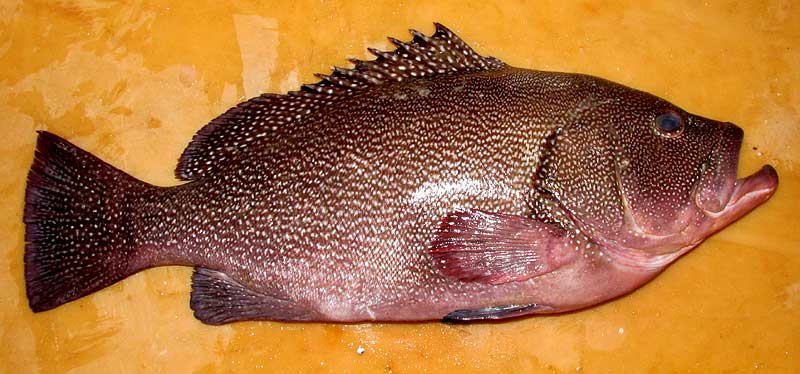Excerpts from Jim Conrad's
Naturalist Newsletter

from the February 8, 2015 Newsletter issued from Río Lagartos, on the Yucatan Peninsula's northern coast (~N21.60°, ~W88.16°), Yucatán state, MÉXICO
CALICO GROUPER
A little stir arose at the fishing cooperative up the street when a fisherman brought in a fish no one had seen before. The meaty-looking, handsome, foot-long mystery is shown above.
I was invited to try to figure out the fish's identity but I was busy on another project so the above picture went off to volunteer identifier Bea in Ontario. Bea quickly determined that we had an EPINEPHELUS DRUMMONDHAYI, known by several evocative English names, including Calico Grouper, Strawberry Grouper, Speckled Hind and Kitty Mitchell.
With the name in hand, the fish's story could be learned. The species occurs throughout the Gulf of Mexico and up the US Atlantic coast to North Carolina. For a long time the Calico Grouper has been considered an important species for sports fishing and commercial fisheries. Our foot-long individual is a small, young one, adults reaching up to 3½ feet long (1.1m) and weighing up to about 65 pounds (30kg).
However, Calico Groupers have suffered greatly from overfishing, and from being caught accidentally when other species are being fished for. When brought up from the deep waters where they're normally found, they suffer "barotrauma" -- they "get the bends" from rapid decompression, and die. Off Bermuda the Calico Grouper once was an important food fish but now it has practically disappeared.
The Calico Grouper's population has suffered such a drastic decline that the IUCN Red List of Threatened Species lists it as "Critically Endangered." The IUCN page detailing the threats, and the reasons for its designation, is found at http://www.iucnredlist.org/details/7854/0.
Adult Calico Groupers inhabit offshore rocky bottoms in depths of 80-600 feet (25-183m) but are most common between 200-400 ft (60-120m). They feed on a variety of fishes and invertebrates, including shrimps, crabs, squid, and octopus. Females mature at four or five years, when they are 1½-2ft long (45-60 cm). Spawning occurs from July to September, and a large female can produce up to 2,000,000 eggs during one spawning.
Despite Calico Groupers being a mystery fish today, I suspect that at one time they were well known and much appreciated among this area's fishermen.